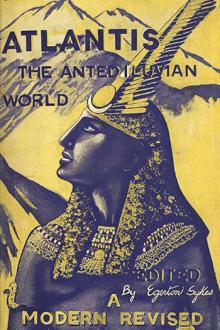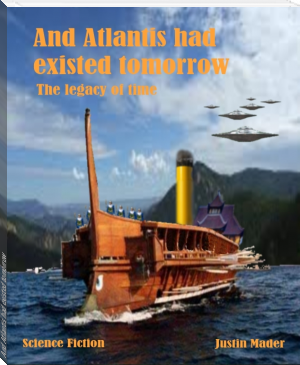Atlantis: The Antedeluvian World by Ignatius Donnelly (thriller novels to read .TXT) 📕

- Author: Ignatius Donnelly
- Performer: -
Book online «Atlantis: The Antedeluvian World by Ignatius Donnelly (thriller novels to read .TXT) 📕». Author Ignatius Donnelly
. they were true negroes.”
7. How comes it that all the civilizations of the Old World radiate from the shores of the Mediterranean? The Mediterranean is a cul de sac, with Atlantis opposite its mouth. Every civilization on its shores possesses traditions that point to Atlantis. We hear of no civilization coining to the Mediterranean from Asia, Africa, or Europe—from north, south, or west; but north, south, east, and west we find civilization radiating from the Mediterranean to other lands. We see the Aryans descending upon Hindostan from the direction of the Mediterranean; and we find the Chinese borrowing inventions from Hindostan, and claiming descent from a region not far from the Mediterranean.
The Mediterranean has been the centre of the modern world, because it lay in the path of the extension of an older civilization, whose ships colonized its shores, as they did also the shores .of America. Plato says, “the nations are gathered around the shores of the Mediterranean like frogs around a marsh.”
Dr. McCausland says:
“The obvious conclusion from these facts is, that at some time previous to these migrations a people speaking a language of a superior and complicated structure broke up their society, and, under some strong impulse, poured out in different directions, and gradually established themselves in all the lands now inhabited by the Caucasian race. Their territories extend from the Atlantic to the Ganges, and from Iceland to Ceylon, and are bordered on the north and east by the Asiatic Mongols, and on the south by the negro tribes of Central Africa. They present all the appearances of a later race, expanding itself between and into the territories of two pre-existing neighboring races, and forcibly appropriating the room required for its increasing population.”
(McCausland’s “Adam and the Adamites,” p. 280.) Modern civilization is Atlantean. Without the thousands of years of development which were had in Atlantis modern civilization could not have existed. The inventive faculty of the present age is taking up the great delegated work of creation where Atlantis left it thousands of years ago.
8. How are we to explain the existence of the Semitic race in Europe without Atlantis? It is an intrusive race; a race colonized on sea-coasts. Where are its Old World affinities?
9. Why is it that the origin of wheat, barley, oats, maize, and rye—the essential plants of civilization—is totally lost in the mists of a vast antiquity? We have in the Greek mythology legends of the introduction of most of these by Atlantean kings or gods into Europe; but no European nation claims to have discovered or developed them, and it has been impossible to trace them to their wild originals. Out of the whole flora of the world mankind in the last seven thousand years has not developed a single food-plant to compare in importance to the human family with these. If a wise and scientific nation should propose nowadays to add to this list, it would have to form great botanical gardens, and, by systematic and long-continued experiments, develop useful plants from the humble productions of the field and forest. Was this done in the past on the island of Atlantis?
10. Why is it that we find in Ptolemy’s “Geography of Asia Minor,” in a list of cities in Armenia Major in A.D. 140, the names of five cities which have their counterparts in the names of localities in Central America?
------------------------------+ | Armenian Cities. | Central American Localities. | ------------------------------+ | Chol. | Chol-ula | ------------------------------+ | Colua. | Colua-can. | ------------------------------+ | Zuivana. | Zuivan. | ------------------------------+ | Cholima. | Colima. | ------------------------------+ | Zalissa. | Xalisco. | ------------------------------+(Short’s “North Americans of Antiquity,” p. 497.) 11. How comes it that the sandals upon the feet of the statue of Chacmol, discovered at Chichen Itza, are “exact representations of those found on the feet of the Guanches, the early inhabitants of the Canary Islands, whose mummies are occasionally discovered in the eaves of Teneriffe?” Dr. Merritt deems the axe or chisel heads dug up at Chiriqui, Central America, “almost identical in form as well as material with specimens found in Suffolk County, England.” (Bancroft’s Native Races,” vol. iv., p. 20.) The rock-carvings of Chiriqui are pronounced by Mr. Seemann to have a striking resemblance to the ancient incised characters found on the rocks of Northumberland, England. (Ibid.) “Some stones have recently been discovered in Hierro and Las Palmas (Canary Islands), bearing sculptured symbols similar to those found on the shores of Lake Superior; and this has led M. Bertholet, the historiographer of the Canary Islands, to conclude that the first inhabitants of the Canaries and those of the great West were one in race.” (Benjamin, “The Atlantic Islands,” p. 130.) 12. How comes it that that very high authority, Professor Retzius (“Smithsonian Report,” 1859, p. 266), declares, “With regard to the primitive dolichocephalæ of America I entertain a hypothesis still more bold, namely, that they are nearly related to the Guanches in the Canary Islands, and to the Atlantic populations of Africa, the Moors, Tuaricks, Copts, etc., which Latham comprises under the name of Egyptian-Atlantidæ. We find one and the same form of skull in the Canary Islands, in front of the African coast, and in the Carib Islands, on the opposite coast, which faces Africa. The color of the skin on both sides of the Atlantic is represented in these populations as being of a reddish-brown.”
13. The Barbarians who are alluded to by Homer and Thucydides were a race of ancient navigators and pirates called Cares, or Carians, who occupied the isles of Greece before the Pelasgi, and antedated the Phœnicians in the control of the sea. The Abbé Brasseur de Bourbourg claims that these Carians were identical with the Caribs of the West Indies, the Caras of Honduras, and the Gurani of South America. (Landa’s “Relacion,” pp. 52-65.)
14. When we consider it closely, one of the most extraordinary customs ever known to mankind is that to which I have already alluded in a preceding chapter, to wit, the embalming of the body of the dead man, with a purpose that the body itself may live again in a future state. To arrive at this practice several things must coexist: a. The people must be highly religious, and possessed of an organized and influential priesthood, to perpetuate so troublesome a custom from age to age.
b. They must believe implicitly in the immortality of the soul; and this implies a belief in rewards and punishments after death; in a heaven and a hell.
c. They must believe in the immortality of the body, and its resurrection from the grave on some day of judgment in the distant future.
d. But a belief in the immortality of the soul and the resurrection of the body is not enough, for all Christian nations hold to these beliefs; they must supplement these with a determination that the body shall not perish; that the very flesh and blood in which the man died shall rise with him on the last day, and not a merely spiritual body.
Now all these four things must coexist before a people proceed to embalm their dead for religious purposes. The probability that all these four things should coexist by accident in several widely separated races is slight indeed. The doctrine of chances is all against it. There is here no common necessity driving men to the same expedient, with which so many resemblances have been explained; the practice is a religious ceremony, growing out of religious beliefs by no means common or universal, to wit, that the man who is dead shall live again, and live again in the very body in which he died. Not even all the Jews believed in these things.
If, then, it should appear that among the races which we claim were descended from Atlantis this practice of embalming the dead is found, and nowhere else, we have certainly furnished evidence which can only be explained by admitting the existence of Atlantis, and of some great religious race dwelling on Atlantis, who believed in the immortality of soul and body, and who embalmed their dead. We find, as I have shown: First. That the Guanches of the Canary Islands, supposed to be a remnant of the Atlantean population, preserved their dead as mummies.
Second. That the Egyptians, the oldest colony of Atlantis, embalmed their dead in such vast multitudes that they are now exported by the ton to England, and ground up into manures to grow English turnips.
Third. That the Assyrians, the Ethiopians, the Persians, the Greeks, and even the Romans embalmed their dead.
Fourth. On the American continents we find that the Peruvians, the Central Americans, the Mexicans, and some of the Indian tribes, followed the same practice.
Is it possible to account for this singular custom, reaching through a belt of nations, and completely around the habitable world, without Atlantis?
15. All the traditions of the Mediterranean races look to the ocean as the source of men and gods. Homer sings of “Ocean, the origin of gods and Mother Tethys.”
Orpheus says, “The fair river of Ocean was the first to marry, and he espoused his sister Tethys, who was his mothers daughter.” (Plato’s “Dialogues,” Cratylus, p. 402.) The ancients always alluded to the ocean as a river encircling the earth, as in the map of Cosmos (see page 95
ante); probably a reminiscence of the great canal described by Plato which surrounded the plain of Atlantis. Homer (Iliad, book xviii.) describes Tethys, “the mother goddess,” coming to Achilles “from the deep abysses of the main:”
“The circling Nereids with their mistress weep, And all the sea-green sisters of the deep.”Plato surrounds the great statue of Poseidon in Atlantis with the images of one hundred Nereids.
16. in the Deluge legends of the Hindoos (as given on page 87 ante), we have seen Manu saving a small fish, which subsequently grew to a great





Comments (0)